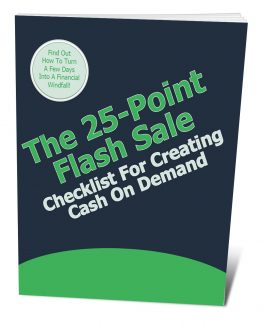
 License Type: Private Label Rights
License Type: Private Label Rights  File Type: ZIP
File Type: ZIP
 SKU: 64015
SKU: 64015  Shipping: Online Download
Shipping: Online Download
Sample Content Preview
The 25-Point Flash Sale Checklist For Creating Cash On Demand
A flash sale is a great way to generate a lot of sales and excitement in a very short period of time. The best way to do this is to plan it several weeks out, bring in your marketing partners to promote the event, and build anticipation among your prospects.
How do you do that? By following this 25-point checklist. Take a look…
1. Define a Goal
The very first thing you need to do is define your goal for this sale. Ideally you should have just one primary goal to focus on, though you may have secondary goals as well. These goals may include:
Customer acquisition.
Generate sales for frontend profits.
Boost backend profits.
Create affiliate excitement.
Create a buzz in the niche about your products.
Establish yourself as a “big player” in the niche.
Build your mailing lists.
Generate excitement about a particular product.
Pick your primary goal, and then move onto the next step…
2. Pick An In-Demand Offer
No matter what your goal is, you need to promote an in-demand offer. Throwing a flash sale for one of your most popular products serves this purpose. However, you can also run a flash sale on a new offer—just make sure it’s something your market really wants.
In other words, do your market research first! Specifically:
See what the hot sellers in your niche are in marketplaces like ClickBank.com, JVZoo.com, and even Amazon.com.
Survey your market to see what they want.
Take note of what the top marketers in your niche are selling on their websites, through their newsletters, and to their social media followers.
Check out what type of products people are paying money to advertise on Google, on top sites in your niche, and even on Facebook.
Use a keyword tool like WordTracker.com or MarketSamurai.com to uncover what your niche is looking for.
Once you have a popular product in hand, then move on…
3. Choose a Date
Now choose a date for your flash sale. Keep these points in mind:
Choose a date that is at least two to three weeks away. This gives you and your affiliates time to prepare.
Research the date to find out if there is anything major going on at the same time. For example, if a really popular marketer in your niche is launching a huge product on the same date, you’ll have a harder time getting affiliates onboard and getting customers to take notice.
Next…
4. Decide on Your Sale Offer
Here’s where you decide on the following points:
What all will you include in the offer? For example, are you going to toss in an extra bonus or two to make the offer even more attractive?
What percentage-off or discount are you offering? Hint: A flash sale should be a really attractive offer, such as 40% off or more the regular price.
What percentage will you give to affiliates? This is partly going to depend on your goals. If you’re looking at building a list, getting affiliates really involved and generating backend profits, then you may consider giving all or most of the frontend commissions to affiliates. If you’re looking at generating a lot of frontend profits, then you can offer a more standard 50% commission rate for affiliates. (This is assuming you are selling digital products—commissions of course are smaller if you’re selling physical products.)
Next…
5. Determine How Long It Will Run
As the name implies, a flash sale happens fast – it’s usually over in a matter of hours. Generally, this may be anywhere from four hours twenty-four hours.
Determine the start and end times.
Figure on running it for at least 8-12 hours for maximum exposure.
Take your prospects’ time zones and activities (such as work) into consideration when deciding the start and end times. In other words, you don’t want the entire sale to fall within the work day, otherwise you’ll have a lot of people missing out.







